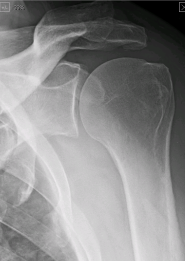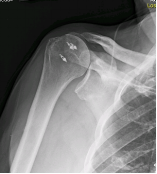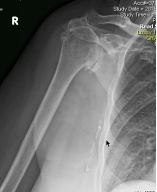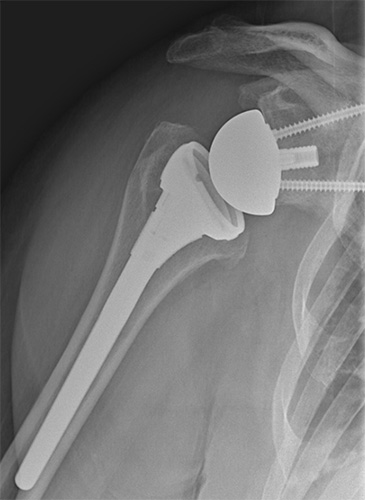Reverse Total Shoulder Replacement
Anatomy and function of the shoulder

The shoulder is a ball-and-socket joint between the upper arm bone, which is called the humerus, and the shoulder blade, which is called the scapula. The ball is on the top of the upper arm bone and the socket is on the shoulder blade. However, the socket is not a full cup, it is a shallow depression similar to a golf tee. To prevent the ball from slipping over the edge of the shallow socket and dislocating with heavy lifting, the rotator cuff compresses the ball into the socket. The rotator cuff is a group of four muscles and tendons (the supraspinatus, the infraspinatus, the subscapularis, and the teres minor) that surrounds the ball like a glove. When the ball is compressed into the socket, the shoulder joint is a stable rotational fulcrum for the powerful deltoid muscle that forms the rounded curve of the shoulder. This stable rotational fulcrum allows the arm to lift heavy weights above shoulder and head level.
Rotator cuff damage

When the rotator cuff has a large tear or extensive damage, the shoulder does not function normally. If the tear is large enough, the shoulder joint is no longer a stable fulcrum and the ball does not remain contained in the socket. This can be painful and limiting. This can also result in a loss of the ability to raise the arm, which can be disabling. If this process is treated early enough, some surgeons hope that rotator cuff repair may be able to reverse this process.
Rotator cuff tear arthropathy

With time, rotator cuff damage can also result in a special kind of arthritis of the shoulder. This kind of arthritis is called “rotator cuff tear arthropathy” with “arthropathy” meaning a problem with the joint surface, with this particular problem being due to the rotator cuff tear. Similar to arthritis elsewhere in the body, the cartilage surfaces of the joint are worn away until the humerus bone is rubbing against the scapula bone. Arthritis creates inflammation, swelling, pain, stiffness, weakness, and loss of shoulder function. Similar to the normal shoulder, a regular shoulder replacement can only function well and be pain-free with a functional rotator cuff. Without a rotator cuff, a regular shoulder replacement can lead to persistent pain, stiffness, and loosening of the replacement.
Reverse total shoulder replacement

The reverse total shoulder replacement was developed for patients with arthritis related to a rotator cuff tear This procedure is also performed for large rotator cuff tears that cannot be repaired. In the reverse replacement, the ball is placed on the shoulder blade and the socket is placed on the upper arm bone. The ball is made from a highly polished metal alloy and the socket is made from a very durable plastic. The reverse replacement has several benefits. The reversed polarity of the joint provides a stable fulcrum so that motion and strength are improved. Similar to other joints, the artificial joint also removes pain, stiffness, weakness, and inflammation from arthritis. Reverse shoulder replacement has been performed in Europe since the 1980s and in the United States since 2003. Shoulder replacement surgery is usually a successful surgery, with most patients having little remaining pain and good restoration of their motion and function.
Click here to download the PDF.
You will need the Adobe Reader to view and print these documents 
